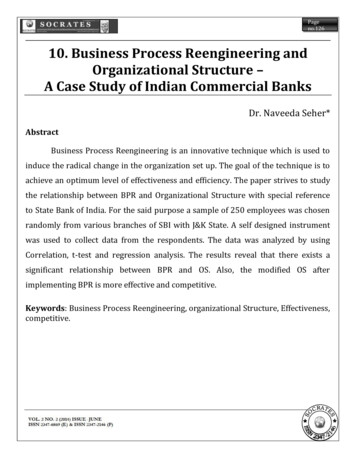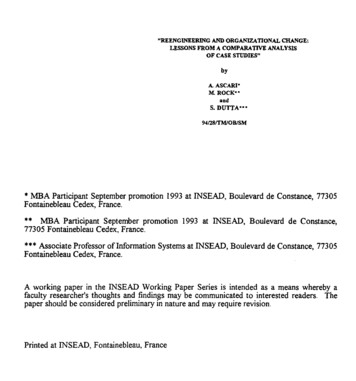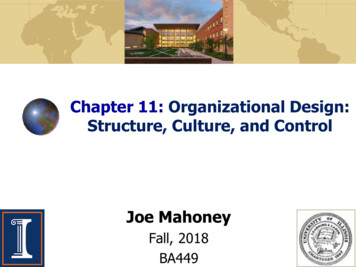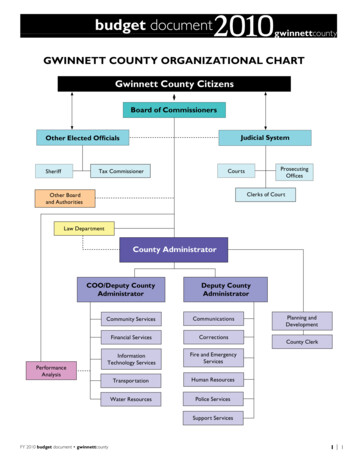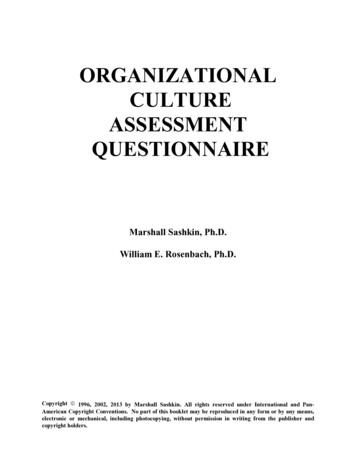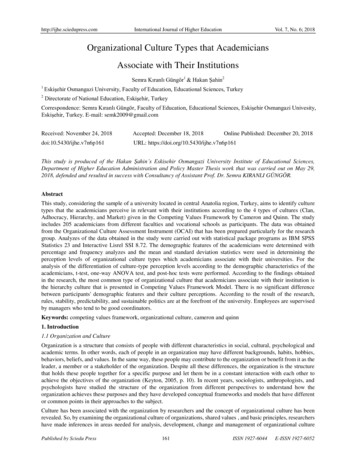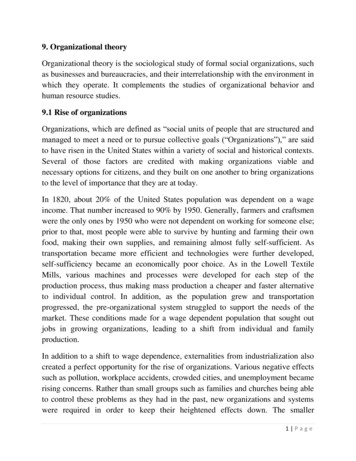
Transcription
9. Organizational theoryOrganizational theory is the sociological study of formal social organizations, suchas businesses and bureaucracies, and their interrelationship with the environment inwhich they operate. It complements the studies of organizational behavior andhuman resource studies.9.1 Rise of organizationsOrganizations, which are defined as “social units of people that are structured andmanaged to meet a need or to pursue collective goals (“Organizations”),” are saidto have risen in the United States within a variety of social and historical contexts.Several of those factors are credited with making organizations viable andnecessary options for citizens, and they built on one another to bring organizationsto the level of importance that they are at today.In 1820, about 20% of the United States population was dependent on a wageincome. That number increased to 90% by 1950. Generally, farmers and craftsmenwere the only ones by 1950 who were not dependent on working for someone else;prior to that, most people were able to survive by hunting and farming their ownfood, making their own supplies, and remaining almost fully self-sufficient. Astransportation became more efficient and technologies were further developed,self-sufficiency became an economically poor choice. As in the Lowell TextileMills, various machines and processes were developed for each step of theproduction process, thus making mass production a cheaper and faster alternativeto individual control. In addition, as the population grew and transportationprogressed, the pre-organizational system struggled to support the needs of themarket. These conditions made for a wage dependent population that sought outjobs in growing organizations, leading to a shift from individual and familyproduction.In addition to a shift to wage dependence, externalities from industrialization alsocreated a perfect opportunity for the rise of organizations. Various negative effectssuch as pollution, workplace accidents, crowded cities, and unemployment becamerising concerns. Rather than small groups such as families and churches being ableto control these problems as they had in the past, new organizations and systemswere required in order to keep their heightened effects down. The smaller1 Page
associations that had contained various social issues in the past were no longerviable, and instead were collapsed into larger formal organizations. Theseorganizations were less personal, more distant, and more centralized; but, whatthey lacked in locality, they made up for in efficiency. Along with wagedependency and externalities, growth of industry also played a large role in thedevelopment of organizations. Markets that were quickly growing and expandingneeded employees right away – because of that, a need developed fororganizational structures that would help guide and support these new employees.Some of the first New England factories relied on daughters of farmers at theironset; later, as the economy changed, they began to gain work from the farmers,and finally, European immigrants. Many Europeans left their homes for thepromises of US industry, and about 60% of those immigrants stayed in the country.They became a permanent class of workers in the economy, which allowedfactories to increase production and produce more than they had before.[1] Withthis large growth came the need for organizations and leadership that was notpreviously needed in small businesses and firms.Overall, the historical and social context in which organizations rose in the UnitedStates allowed for not only the development of organizations, but also for theirspread and growth. Wage dependency, externalities, and growth of industries allplayed into the change from individual, family, and small-group production andregulation to large organizations and structure.Even though the decline in small business might not seem to substantiate how thedevelopment in organizations leads to increased aggregate economic return, itexemplifies the cut-throat nature of capitalism. As organizations develop, theydevour the smaller organizations that cannot keep up, but also allow for theevolution of innovative management and production techniques for other largercompanies. The development of organizations demands a higher level of skillsetfrom workers as it continues to grow. It also builds precautionary measures oncutting edge technology. It amplifies the need for specialization and accounts offunctionalism in various organizations and their respective societies. Throughmuch advancement in the interaction of capitalistic bureaucracies, the developmentof organizations is what has driven contemporary firms to thrive in its modern daysociety.2 Page
9.2 Competing theories of organizationAs organizations are implemented over time, many people experimented as towhich one was best. These theories of organizations include Bureaucracy,Rationalization (Scientific Management), and the Division of Labor. Each theoryprovides distinct advantages and disadvantages when implemented. However,there is no best way to organize labor. For instance, the division of labor may bemore effective for a car company, while a bureaucracy is more effective for agovernment program such as the FDA.-Weber's Ideal of Bureaucracy Official Jurisdiction on all areas are ordered byrules or laws already implemented.-There is an office hierarchy; a system of super- and subordination in which thereis supervision of lower office by higher ones.-The management of the modern office is based upon written rule, which arepreserved in original form.-Office management requires that of training or specialization.-When the office is developed/established it requires the full working capacity ofindividuals.-Rules are stable and can be learned. Knowledge of these rules can be viewed asexpertise within the bureaucracy (these allow for the management of society)-When a bureaucracy is implemented, they can provide accountability,responsibility, control, and consistency. The hiring of employees will be animpersonal and equal system.Although the classical perspective encourages efficiency, it is often criticized asignoring human needs. Also, it rarely takes into consideration human error or thevariability of work performances (each worker is different).Challenger Tragedy: overlooked the possibility of human error. Three MileIsland Incident3 Page
9.3 Rational system perspectiveIn a rational organization system, there are two significant parts: Specificity ofGoals and Formalization. Goal specification provides guidelines for specific tasksto be completed along with a regulated way for resources to be allocated.Formalization is a way to standardize organizational behavior. As a result, therewill be stable expectations, which create the rational organizational system.Scientific Management: Taylor analyzed how to maximize the amount of outputwith the least amount of input. This was Taylor’s attempt to rationalize theindividual worker.1.Divide work between managers and workers2.Provide incentive system (based on performance)3.Scientifically trained workers4.Create a science for each individual’s responsibilities5.Make sure work is done on time/efficientlyThere are problems that arose out of scientific management. One is that thestandardization leads workers to rebel against the mundanes. Another is thatworkers may reject the incentive system because they are required to constantlywork at their optimum level, an expectation that may be unrealistic.9.4 Division of laborThe division of labor is the specialization of individual labor roles. It is oftenassociated with increasing output and trade. According to Adam Smith, thedivision of labor is efficient due to three reasons: occupational specialization,saving from not changing tasks, and machines taking the place of human labor.Occupational specialization leads to increased productivity and distinct skill. Also,Smith argued that human and physical capital must be similar or matched; if theskill of workers were matched with technological improvements, there would be amajor increase in productivity.4 Page
Although the division of labor is often viewed as inevitable in a capitalistic society,there are several specific problems that may arise. They include a lack ofcreativity, monotony, and lack of mobility. Creativity will naturally suffer due themonotonous atmosphere that the division of labor creates. Doing the same routinesmay not be for everyone. Also, employees aren’t familiar with other parts of thejob. They cannot assist employers of different parts of the system.9.5 Modernization theoryModernization “began when a nation’s rural population started moving from thecountryside to cities” (Shah 3).It deals with the cessation of traditional methods inorder to pursue more contemporary effective methods of organization.Urbanization is an inevitable characteristic of society because the formation ofindustries and factories induces profit maximization. It is fair to assume that alongwith the increase in population, as a result of the subsequent urbanization, is thedemand for an intelligent and educated labor force (Shah 3). Following the 1950s,Western culture utilized the effects of mass media coverage to communicate theirgood fortune attributed to modernization. The coverage promoted “psychicmobility” among the social class and increased the aspirations of many hopefuls indeveloping economic countries (Shah 4). Under this theory, any country couldmodernize by using Western civilization as a template.Although this theory of modernization seemed to pride itself on only the benefits,countries in the Middle East saw this movement in a new light. Middle Easterncountries believed that the media coverage of modernization implied that the more“traditional” societies have not “risen to a higher level of technologicaldevelopment” (Shah 6).Consequently, they believed a movement that benefitsthose who have the monetary resources to modernize technological developmentwould discriminate against the minorities and poor masses (Shah 6). Thus, theywere reluctant to modernize because of the economic gap it would create betweenthe rich and the poor.5 Page
The growth of modernization took place beginning in the 1950s. For the ensuingdecade, people analyzed the diffusion of technological innovations within Westernsociety and the communication that helped it disperse globally (“Modernizationtheory”). This first “wave” as it became known had some significant ramifications.First, economic development was enhanced from the spread of new technologicaltechniques. And second, modernization supported a more educated society (asmentioned above), and thus a more qualified labor force (“ModernizationTheory”). The second wave took place between the years 1960 and 1970. Thisperiod was labeled anti-modernization, because it saw the push of innovations ofWestern society onto developing countries as an exertion of dominance(“modernization theory”). It refuted the concept of relying heavily on mass mediafor the betterment of society. The last wave of modernization theory, which tookplace in the 1990s, depicts impersonality (Perrow 737). As uses of newspapers,TVs, and radios become more prevalent, the need for direct contact, a concepttraditional organizations took pride in, diminishes. Thus, organizationalinteractions become more distant (“Modernization Theory”).According to Frank Dobbin, the modern worldview is the idea that “moderninstitutions are transparently purposive and that we are in the midst an evolutionaryprogression towards more efficient forms (138).” This phrase epitomizes the goalof modern firms, bureaucracies, and organizations to maximize efficiency. The keyto achieving this goal is through scientific discoveries and innovations (Dobbin139). Dobbin discusses the outdated role of culture in organizations. “NewInstitutionalists” explored the significance of culture in the modern organization(Dobbin 117). However, the rationalist worldview counters the use of culturalvalues in organizations, stating, “transcendental economic laws exist, that existingorganizational structures must be functional under the parameters of those laws,[and] that the environment will eliminate organizations that adopt non-efficientsolutions” (Dobbin 138). These laws govern the modern organizations and leadthem in the direction that will maximize profits efficiently. Thus, the modernity oforganizations is to generate maximum profit, through the uses of mass media,technological innovations, and social innovations in order to effectively allocateresources for the betterment of the global economy.6 Page
9.6 Classical perspectiveThe classical perspective emerges from the Industrial Revolution and centers ontheories of efficiency. There are two subtopics under the classical perspective: thescientific management and bureaucracy theory.Efficiency and teleological arguments in Weberian bureaucracyMax Weber believed that an ideal bureaucracy consists of six specificcharacteristics: hierarchy of authority, impersonality, written rules of conduct,promotion based on achievement, specialized division of labor, and efficiency.[14]This ultimate characteristic of Weberian bureaucracy, which states thatbureaucracies are very efficient, is controversial and by no means accepted by allsociologists. There are certainly both positive and negative consequences tobureaucracy, and strong arguments for both the efficiency and inefficiency ofbureaucracies.While Max Weber’s work was published in the late 1800s and early 1900s, beforehis death in 1920, his work is still referenced today in the field of sociology.Weber’s theory of bureaucracy claims that it is extremely efficient, and even goesas far as to claim that bureaucracy is the most efficient form of organization.Weberclaimed that bureaucracies are necessary to ensure the continued functioning ofsociety, which has become drastically more modern and complex in the pastcentury. Furthermore, he claimed that without the structured organization ofbureaucracy, our complex society would be much worse off, due to the fact thatsociety would act in an inefficient and wasteful way. He saw bureaucracies asorganizations driven towards certain goals, which they could carry out efficiently.In addition, within an organization that operates under bureaucratic standards, themembers will be better off due to the heavy regulation and detailed structure. Notonly does bureaucracy make it much more difficult for arbitrary and unfairpersonal favors to be carried out, it also means that promotions and hiring willgenerally be done completely by merit.Weber most definitely saw bureaucracies as goal-driven, efficient organizations,but one must not come to the quick and incorrect conclusion that he saw nodownfalls to bureaucracy. He recognized that there are constraints within thebureaucratic system. First of all, he realized that bureaucracies were ruled by very7 Page
few people with very large amounts of unregulated power. This tends to lead to asituation of oligarchy, whereby a limited number of officials become the politicaland economic power. Furthermore, Weber considered further bureaucratization tobe an “inescapable fate,” due to the fact that it is supposedly superior to and moreefficient than other forms of organization. Weber’s analysis of bureaucracies ledhim to believe that they are too inherently limiting to individual human freedomand he feared that people would begin to be too controlled by bureaucracies. Hisrationale comes from the knowledge that the strict methods of administration andlegitimate forms of authority associated with bureaucracy act to eliminate humanfreedom.Regardless of whether or not bureaucracies should be considered positivelyefficient or too efficient to the extent that they become negative, Weberianbureaucracy tends to offer a teleological argument. A theory, in this casebureaucracy, is considered to be teleological if it involves aiming at specific goals.Weber claimed that bureaucracies are goal-oriented organizations, which use theirefficiency and rational principles to reach their goals. A teleological analysis ofbusinesses leads to the inclusion of all involved stakeholders in decision-making.The teleological view of Weberian bureaucracy postulates that all actors in anorganization have various ends or goals, and attempt to find the most efficient wayto achieve these goals.9.7 Scientific ManagementThe Scientific Management theory was introduced by Frederick Winslow Taylor toencourage production efficiency and productivity. Taylor argues that inefficienciescould be controlled through managing production as a science. Taylor definesscientific management as "concerned with knowing exactly what you want men todo and then see in that they do it in the best and cheapest way."According toTaylor, scientific management affects both workers and employers, and stressesthe control of the labor force by management.8 Page
9.7.1 Principles of Scientific ManagementTaylor identifies four inherent principles of the scientific management theory.1.The creation of a scientific method of measurement that replaces the "rule-ofthumb" method2.Emphasis placed on the training of workers by management3.Co-operation between manager and workers to ensure the principles are beingmet4.Equal Division of labour between managers and workers9.7.2 Bureaucratic TheoryThe scholar most closely associated with Bureaucratic theory is Max Weber. InEconomy and Society, his seminal book published in 1922, Weber articulates thenecessary conditions and descriptive features of bureaucracy. An organizationgoverned under Weber’s conception of bureaucracy is characterized by thepresence of impersonal positions that are earned and not inherited, rule-governeddecision-making, professionalism, chain of command, defined responsibility, andbounded authority.Weber begins his discussion of bureaucracy by introducing the concept of‘jurisdictional areas’: institutions governed by a specific set of rules or laws. In a‘jurisdictional area’ regular activities are assigned as official duties, the authorityto assign these duties is distributed through a set of rules, and duties are fulfilledcontinuously by qualified individuals. These elements make up a bureaucraticagency in the case of the state and a bureaucratic enterprise in the private economy.There are several additional features that comprise a Weberian bureaucracy:It is possible to find the utilization of hierarchical subordination in all bureaucraticstructures. This means that higher-level offices supervise lower level offices.In bureaucracies, personal possessions are kept separate from the monies of theagency or the enterprise.9 Page
People who work within a bureaucracy are usually trained in the appropriate fieldof specialization.Bureaucratic officials are expected to contribute their full working capacity to theorganization.Positions within a bureaucratic organization must follow a specific set of generalrules.Weber argued that in bureaucracy, taking on a position or office signifies anassumption of a specific duty necessary for the organization. This conception isdistinct from historical working relationships in which a worker served a specificruler, not an institution.The hierarchical nature of bureaucracies allows employees to demonstrateachieved social status When an office holder is elected instead of appointed, thatperson is no longer a purely bureaucratic figure. He derives his power ‘frombelow’ instead of ‘from above.’ When a high-ranking officer selects officials, theyare more likely to be chosen for reasons related to the benefit of the superior thanthe competency of the new hire. When high-skilled employees are necessary forthe bureaucracy and public opinion shapes decision-making, competent officers aremore likely to be selected.According to Weber, if ‘tenure for life’ is legally guaranteed, an office becomesperceived as less prestigious than a position that can be replaced at any time. If‘tenure for life’ or a ‘right to the office’ develops, there is a decrease in careeropportunities for ambitious new hires and overall technical efficiency becomes lessguaranteed.In a bureaucracy, salaries are provided to officials. The amount is determined onthe basis of rank and helps to signify the desirability of a position. Bureaucraticpositions also exist as part of stable career tracks that reward office-holders forseniority.Weber argues that the development of a ‘money economy’ is the “normalprecondition for the unchanged survival, if not the establishment, of purebureaucratic administrations”. Since bureaucracy requires sustained revenues from10 P a g e
taxation or private profits in order to be maintained, a money economy is the mostrational way to ensure its continued existence.Weber posits that officials in a bureaucracy have a property right to their office andattempts at exploitation by a superior means the abandonment of bureaucraticprinciples. He articulates that providing a status incentive to inferior officers helpsthem to maintain self-respect and fully participate in hierarchical frameworksMichel Crozier reexamined Weber’s theory in 1964. He determined thatbureaucracy is flawed because hierarchy causes officers to engage in selfish powerstruggles that damage the efficiency of the organization.9.7.3 Criticism of the classical perspectiveWeber’s theories were purposed to set a stage for other organizations to follow,and the characteristics are so ideal that they may be impossible for any actualorganization to succeed. He wanted to come up with a set of guidelines that wouldfavor both efficiency and, most importantly, conditions that would make theworkers top priority. It was common for earlier theorists to distort Weber’s views,and today, people still make the same mistakes as they did when Weber’s viewsfirst came into play. He has always been critiqued for the branches of his ideas thatdon’t work in reality, but the point of his theory was not to actually create anorganization, but to create an ideal model for other organizations to follow.One big misconception that people have had in the past is a question of Weber’smorality due to their oversimplification of his characteristics of a purebureaucracy. “There is dangerous risk of oversimplification in making Weber seemcold and heartless to such a degree that an efficiently-run Nazi death camp mightappear admirable” (Bureaucracy Theory). In reality, Weber believed that by usinghuman logic in his system, we could achieve improvement of human condition invarious workplaces. Complexity in an organization yields the highest success,therefore simplifying it leads to the illusions of over-authority and intensehierarchical power that are inaccurate of Weber’s beliefs.11 P a g e
Another critique of Weber’s theory is the argument of efficiency. Highestefficiency, in theory, can be attained through pure work with no regard for theworkers (for example, long hours with little pay), which is why oversimplificationcan be dangerous. If we were to take one characteristic focusing on efficiency, itwould seem like Weber is promoting unhealthy work conditions, when in fact, hewanted the complete opposite. Put all of them together, and we have the idealorganization, but since a pure bureaucracy is nearly impossible to obtain,efficiency takes the back seat in his beliefs. Though his theories includecharacteristics of a highly efficient organization, we must remember that thesecharacteristics are only meant to set a model for other organizations to follow, andif all the other conditions are not perfect, the organization is not pure. Is it really abad thing that Weber’s priorities were for the people rather than the companyitself?With this said, the characteristics of Weber’s theory have to all be perfect for abureaucracy to function at its highest potential. “Think of the concept as a bureauor desk with drawers in it, which seems to call out to you, demanding thateverything must fit in its place” (Bureaucracy Theory). If one object in the drawerdoes not fit properly, the entire drawer becomes untidy, which is exactly the casein Weber’s theory; if one characteristic is not fulfilled the rest of them are unableto work in unison, leaving the organization performing below its full potential.One characteristic that was meant to better workplace conditions was his rule that“Organization follows hierarchical principle -- subordinates follow orders orsuperiors, but have right of appeal (in contrast to more diffuse structure intraditional authority)” (Bureaucracy (Weber)). In other words, everyone in acompany or any sort of work environment has the opportunity and right to disagreeor to speak up if they are unhappy with something rather than not voice theiropinion in fear of losing their job. Open communication is a very important part ofWeber’s ideal bureaucracy, and is practiced today. Because of the communicationit may not be the most efficient, but Weber would argue that improved humanconditions are more important than efficiency.12 P a g e
It is hard to critique Weber’s theories strictly because of the fact that they aretheories; they are nearly impossible to perform in real life, therefore how can weknow if they work or not? They are merely a set of guidelines that make upbureaucracy, which today many believe is the best way to run organizations in allaspects.9.7.4 Neoclassical perspectiveThe Neoclassical perspective began with the Hawthorne studies in the 1920s. Thisapproach gave emphasis to “affective and socio-psychological aspects of humanbehaviours in organizations.” The human relations movement was a movementwhich had the primary concerns of concentrating on topics such as morale,leadership, and mainly factors that aid in the cooperation in Organizationalbehavior.9.7.4 Hawthorne studyA number of sociologists and psychologists made major contributions to the studyof the neoclassical perspective, which is also known as the human relations schoolof thought. Elton Mayo and his colleagues were the most important contributors tothis study because of their famous Hawthorne study from the “Hawthorne plant ofthe Western Electric Company between 1927 and 1932.”The Hawthorne study suggested that employees have social and psychologicalneeds along with economic needs in order to be motivated to complete theirassigned tasks. This theory of management was a product of the strong oppositionagainst “the Scientific and universal management process theory of Taylor andFayol.” This theory was a response to the way employees were treated incompanies and how they were deprived of their needs and ambitions.In November 1924, a team of researcher – professors from the renowned HarvardBusiness school of USA began investigating into the human aspects of work andworking conditions at the Hawthorne plant of Western Electric Company, Chicago.The company was producing bells and other electric equipments for the telephone13 P a g e
industry. Prominent Professors included in the research team were Elton Mayo(Psychologist), Roethlisberger and Whilehead (Sociologist), and William Dickson(Company representative). The team conducted four separate experimental andbehavioural studies over a seven-year period. These were:1.'Illumination Experiments (1924–27) to find out the effect of illumination onworker's productivity.'2.'Relay Assembly Test Room experiment (1927–28) to find out the effect ofchanges in number of work hour and related working condition on workerproductivity.'3.'Experiment in interviewing Working : In 1928, a number of researchers wentdirectly to workers, kept the variables of previous experiment aside, and talkedabout what was, in their opinion, important to them. Around 20,000 workers wereinterviewed over a period of two years. The interviews enabled the researchers todiscover a rich and intriguing world that previously remained undiscovered andunexamined within the Hawthorne studies undertaken so far. The discovery of theinformal organisation and its relationship to the formal organisation was thelandmark of experiments in interviewing workers. These experiment led to a richerunderstanding of the social, interpersonal dynamics of people at work.'4.'Bank wiring Room Experiments (1931–32) to find out social system of anorganisation.'9.7.5 Results from the Hawthorne studiesThe Hawthorne studies helped conclude that “a human/social element operated inthe workplace and that productivity increases were as much an outgrowth of groupdynamics as of managerial demands and physical factors.” The Hawthorne studiesalso concluded that although financial motives were important, social factors arejust as important in defining the worker-productivity.Hawthorne Effect was the improvement of productivity between the employees, itwas characterized by:The satisfactory interrelationships between the coworkers14 P a g e
It classifies personnel as social beings and proposes that sense of belonging in theworkplace is important to increase productivity levels in the workforce.An effective management understood the way people interacted and behavedwithin the group.The management attempts to improve the interpersonal skills through motivations,leading, communication and counseling.This study encourages managers to acquire minimal knowledge of behavioralsciences to be able to understand and improve the interactions between employees9.7.6 Criticism of the Hawthorne studyCritics believed that Mayo gave a lot of importance to the social side of the studyrather than addressing the needs of an organization. Also, they believed that thestudy takes advantage of employees because it influences their emotions bymaking it seem as if they are satisfied and content, however it is merely a tool thatis being used to further advance the productivity of the organization.9.8 Environmental Perspec
9.1 Rise of organizations Organizations, which are defined as “social units of people that are structured and managed to meet a need or to pursue collective goals (“Organizations”),” are said to have risen in the United S


